If you're insanely lucky, you'll have a stud in your wall exactly where you want to hang something heavy. For the other 99% of the time, you're going to need to use a drywall anchor to hang that thing on the wall. (That's a sheetrock anchor for the American folks out there.)

I know. The drywall anchor! It's a big, scary looking thing but once I explain it, it'll be about as scary as a chocolate covered cotton ball. I'll be calling it a drywall anchor through this post by the way because that's what it's called in my area in Canada. You might refer to it as sheetrock and a sheetrock anchor, but it's the same thing.
We've all been there I'm sure ... hung a full sized cow on our wall only to have it fall down in the middle of the night, scaring the farts right out of the cat. It happens. But it doesn't have to.
For some reason people are under the impression that hanging things on the wall is frightening. This fear stems out of two things. The fear of filling your wall with holes (you can overcome that fear in this tutorial where I teach you how to fix nail holes in drywall), and the fear of having no idea what the hell you're doing, what the hell you're supposed to use and how the hell you're supposed to use it.
Also you hung something once before and it fell down. And it was traumatizing.
But that's only because you probably used the wrong types of drywall anchors. I bet you're using those little, brightly coloured plastic wall anchors aren't you?
It's O.K. Not knowing, making mistakes, asking questions and learning are all a part of your successful home improvement journey.
Table of Contents
Plastic Wall Anchors
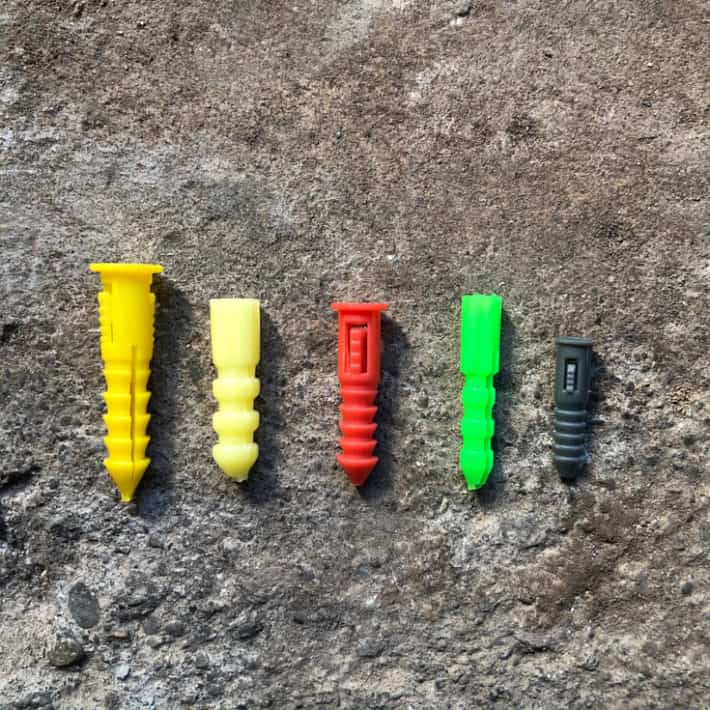
I've used them too. I'll admit it. Those plastic anchors (expansion anchors) in bright colours that you hammer into the drywall. You keep screwing and screwing your screw into it and it just keeps spinning and spinning because it isn't actually grabbing onto anything. But you hang something off of it anyways because you paid for it and installed it and can't think of any other way to do it. Then your cow falls down.
It's because those plastic anchors aren't really meant for drywall. They're actually meant for solid walls like concrete. They *can* in certain circumstances be used for drywall but even the must robust plastic anchor can only hold around 10 pounds. So they're very definitely light duty and don't have a lot of holding power.
If you INSIST on using a plastic wall anchor in drywall, remember this tip.
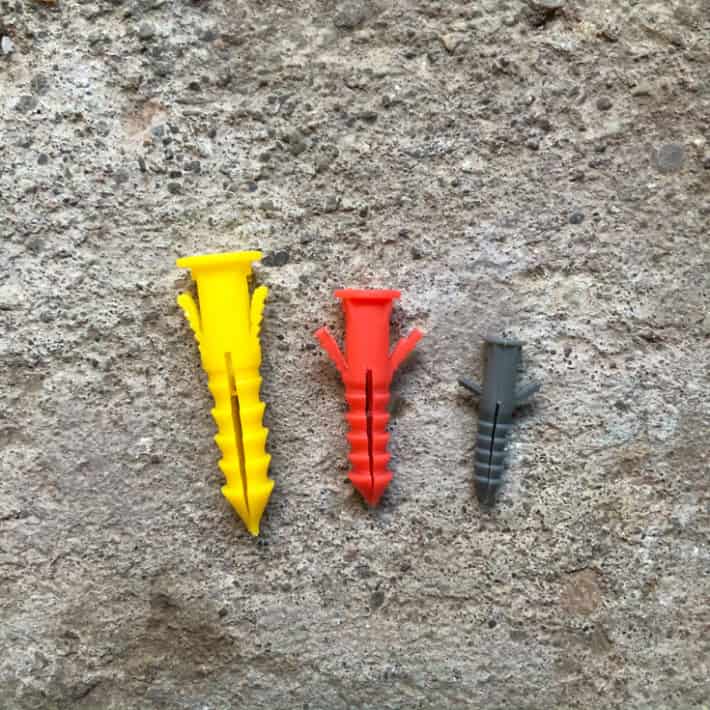
Pull the wings out on your plastic anchor!Not all plastic anchors are going to have them, but if they do, pull them out. They'll squish back in when you hammer the anchor into the wall but they'll pop out again a bit once they're in there. They'll help (a minuscule amount) to keep the anchor from falling out of the wall.
So if plastic wall anchors are crap, what should you be using to hang your stuff on the wall?
Threaded Anchors
Threaded anchors, (also called self-drilling anchors and E-Z anchors) are the absolute easiest choice and one of the most effective. They have a point on the end so you can tap them into the drywall. Then just stick a screwdriver into them and screw them in the wall. An average sized threaded anchor can hold about 50 pounds.
But my favourite is the hollow wall anchor. Otherwise known as a Molly Bolt. It's more complicated to use than the threaded anchor but I like them better.
What is a Molly wall anchor?
Also known as the classic "Molly Bolt" or a molly wall anchor. THESE are the only drywall (sheetrock) anchors you should use. (bit of an exaggeration but honestly if you aren't sure what to go with they are the best.) How do I know they're the best? Just ask Bessie the cow.
These are my favourite anchors. Yes there are others like screw-in anchors, toggle bolts and a bunch of other things, but these Molly wall anchors are my favourites so that's why I'm talking about them and telling you to use them too.
When you buy a box of Hollow Wall Anchors there are 3 things you need to look for on the box:
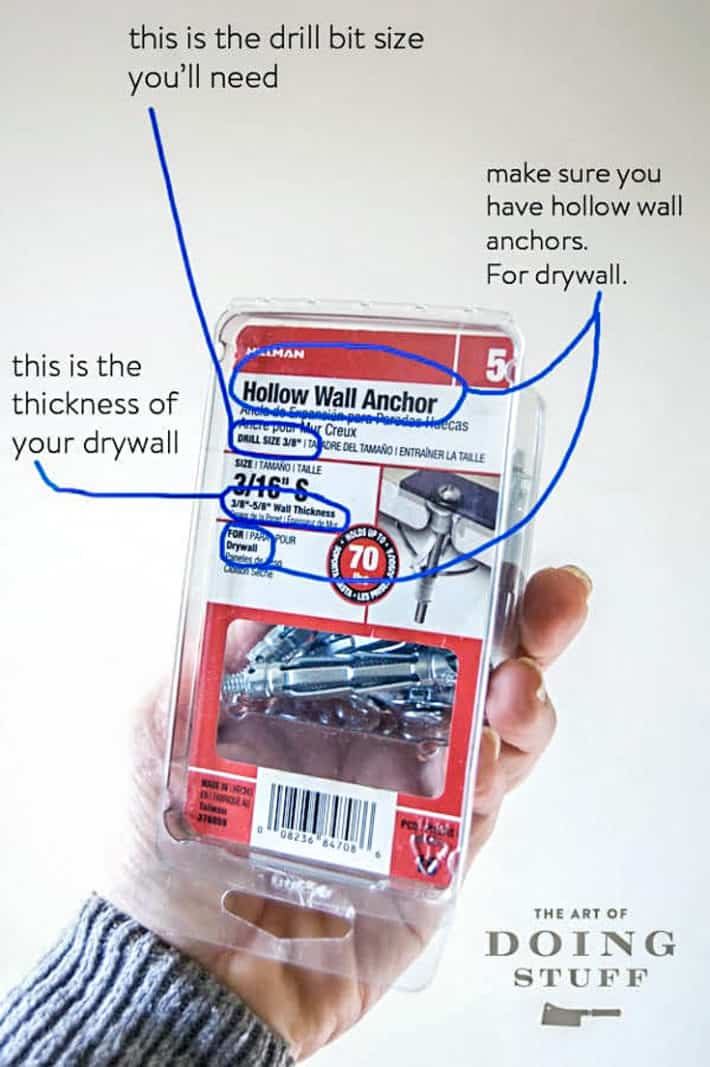
What to look for in Hollow Wall Anchors
- Make sure what you're buying is indeed a Hollow Wall Anchor for drywall.
- Make sure they're the right size for your drywall. This box is good for drywall that is ⅜ths to ⅝ths thickness. (there are other Hollow Wall Anchors that are for very thin materials like hollow doors)
- Note the size of the drill bit that they recommend you use and make sure you own one!
Also make sure you own a drill. I have a couple of drills, a "vintage" electric one I found at a garage sale that's GREAT and this Ryobi cordless one, which is great when the battery actually works. If you have issues with 18V batteries suddenly not charging, read my post on how to get a seemingly dead cordless battery to take a charge.
How to use Molly Bolts To Hang Stuff on Drywall
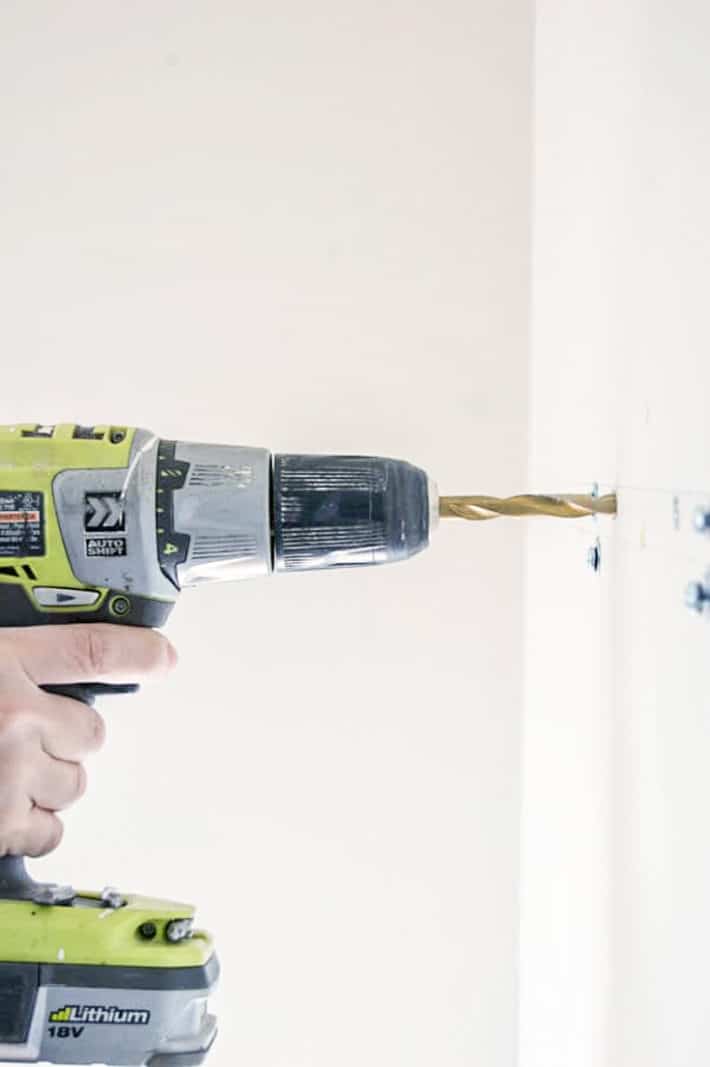
- Mark the place on your wall where you want to hang something. Using the right sized drill bit, drill your hole. DON'T go wiggling all over the place with your drill. Hold it stead and drill straight in and pull straight out. If you wiggle you'll actually drill a larger hole.
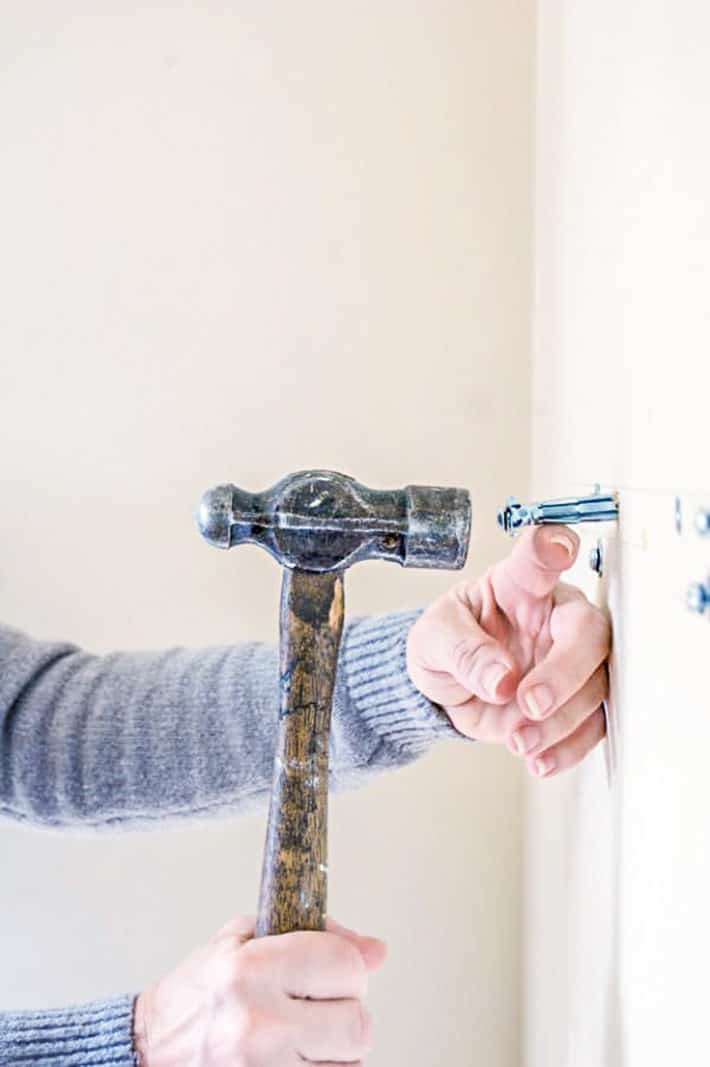
2. Take the Hollow Wall Anchor out of the package and hammer it straight into the wall. You don't have to adjust it or fiddle with it or anything. Just whack it in there.
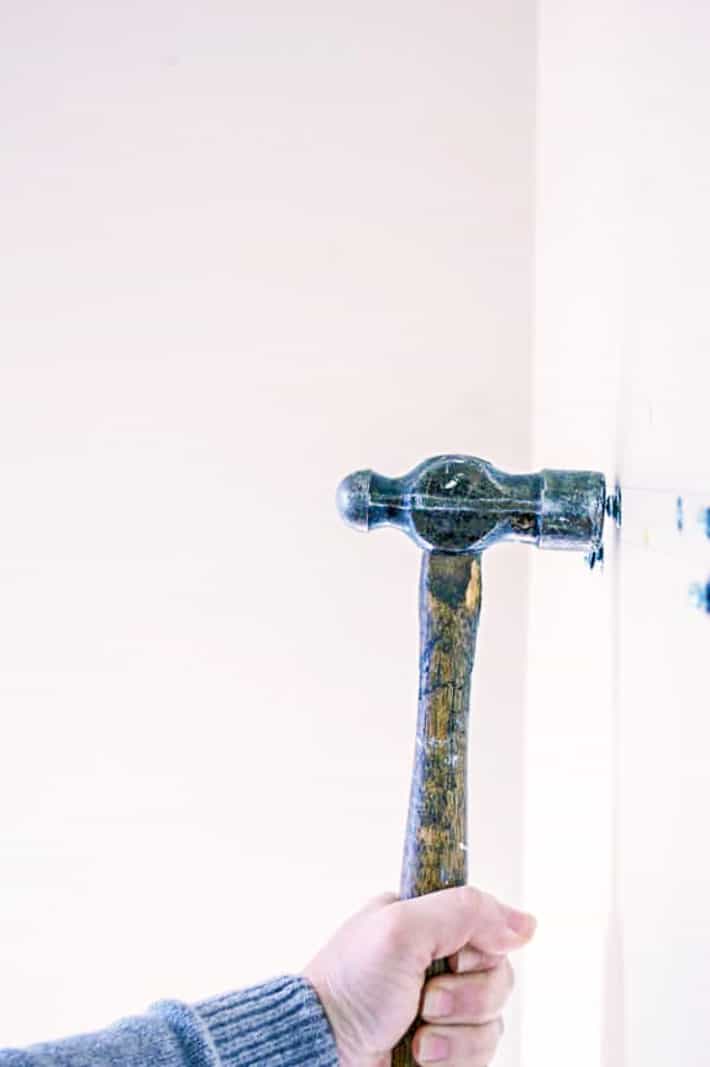
If you look back up at the first picture I showed you you'll see that there's tiny teeth under the flat edge of the anchor. These will grip into the outside of the drywall so make sure you hammer it in good.
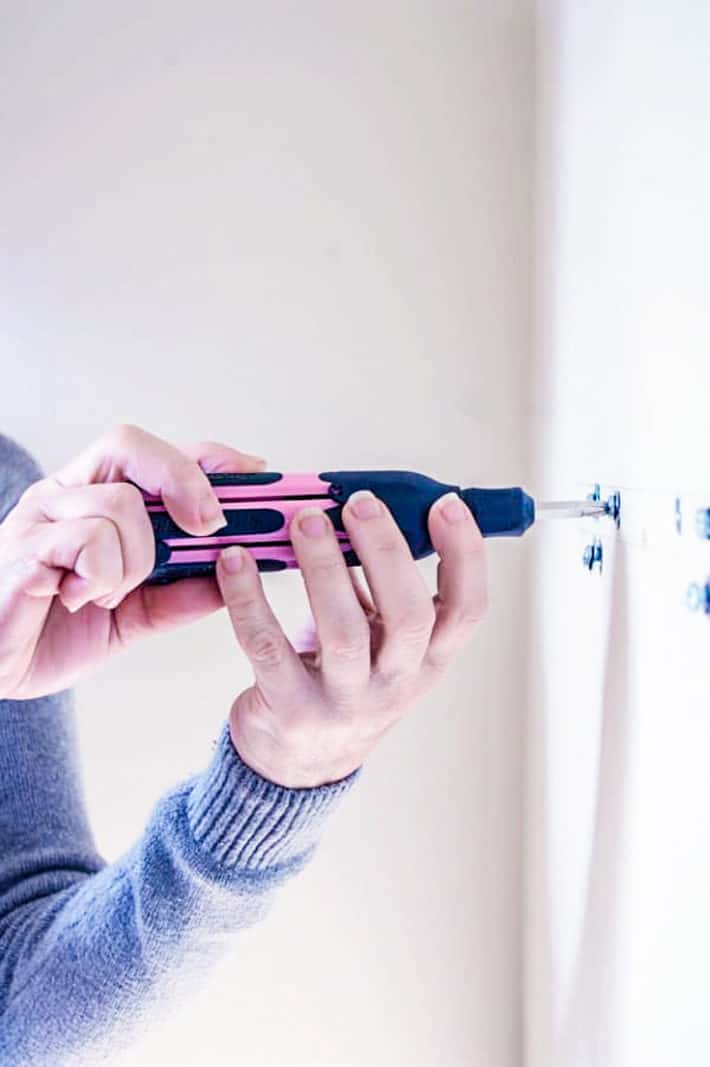
3. Now you get your screwdriver and start screwing the screw in. I know it looks like it's already in (and it is) but what you're doing at this moment is creating Hollow Wall Anchor magic.
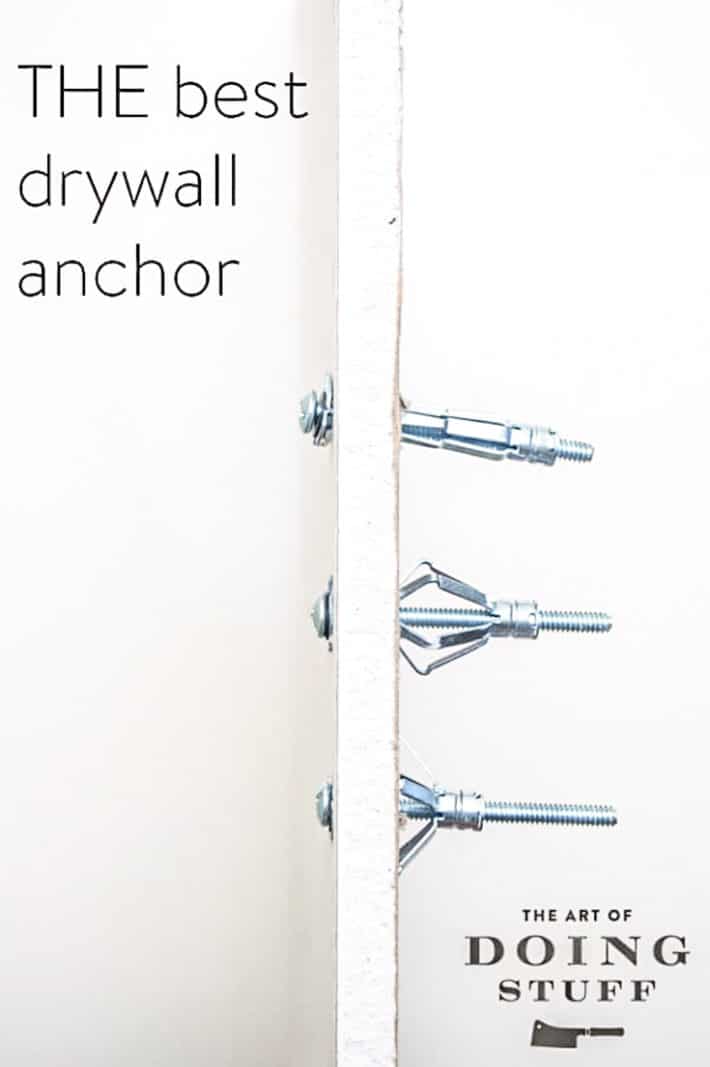
As you screw the screw in, a sort of flange is being pushed out at the back of the drywall. The more you turn the screw the tighter and tighter the flange gets. Just keep turning until you can feel some good resistance. It may take a while and you might get bored.
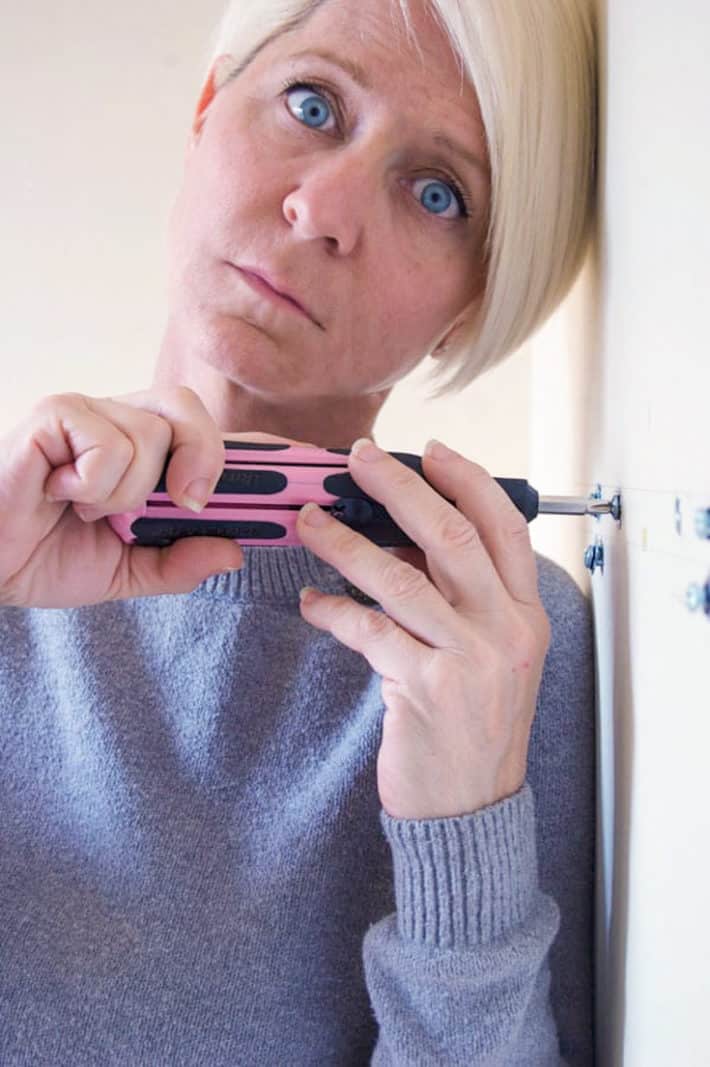
4. Once you've screwed it in to the point that you feel the resistance of the flange (I'm not really sure that's the right word to be using) against the back of the drywall you can start unscrewing the screw. Again. Totally boring.
I recommend doing it by hand though and not with a drill because you don't have enough control over the drill and if you screw your Hollow Wall Anchor in too tightly you could end up squishing your drywall and ruining it. Just do it by hand. Super exercise for your wrist anyway which will come in handy the next time you slap someone.
- If you're only hanging a mirror or picture then you can just pull the screw out enough to get your wire picture hanger over it.
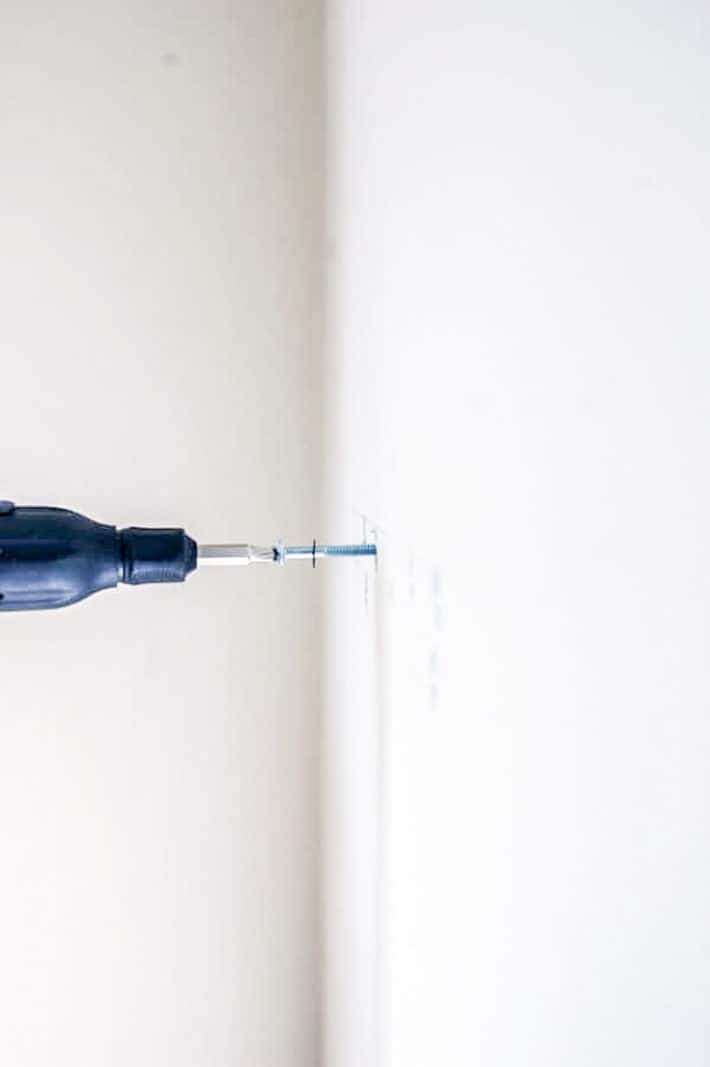
- If you're attaching something to the wall like a bar or TV mount you might have to remove the screw entirely and then, yes, screw it back in again.
And don't worry. Undoing the screw doesn't do anything to the flange. It stays rock solid. That baby's in your wall for good now.
Seriously. To remove a hollow wall anchor you have to just hammer it into the wall and fill the hole it leaves with drywall compound. Yes. I know. That's scared you even more. Calm down. Remember? I showed you how to fix a hole in drywall. It's easy.
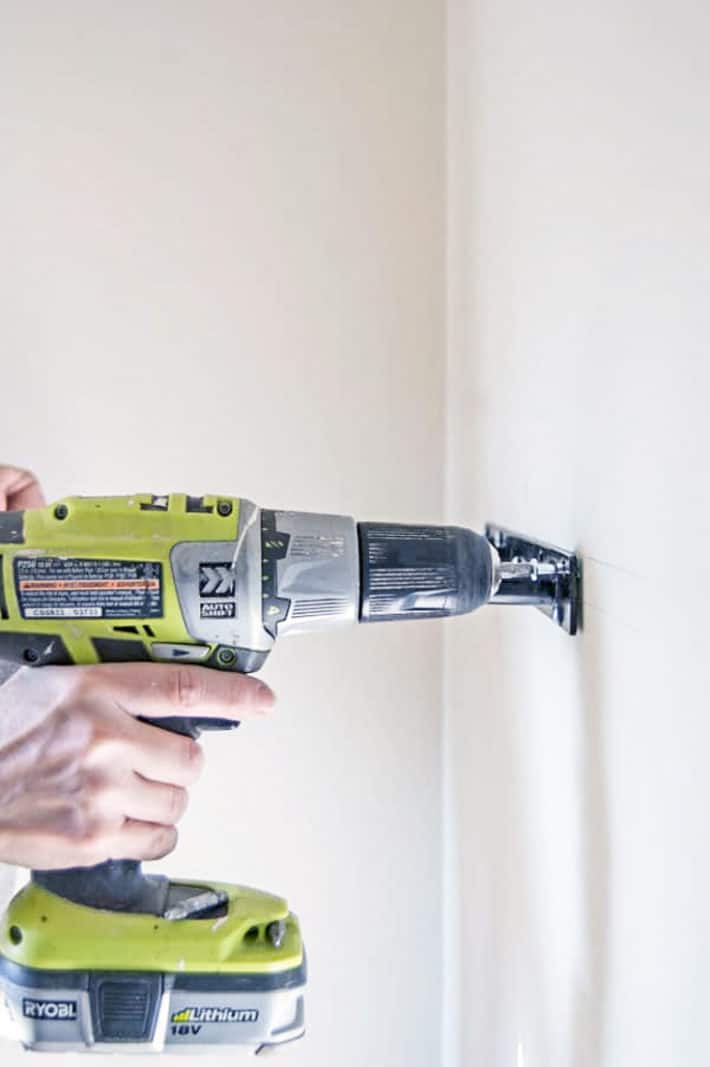
What are the Strongest Drywall Anchors?
If you use either the threaded anchor or the molly bolt you'll do just fine. They can easily hold 50 pounds.
If you want to hang something a very large, heavy picture or mirror these no stud picture hangers are the absolute BEST. They are hooks and specifically for hanging mirrors or heavy artwork and I've used 2 of them to hang the life sized portrait you see in this post. Each of these hooks will support 200 pounds.
You're still scared. You don't think you can do this. It seems ... scary and you're pretty sure you're never going to need to hang anything on your walls. Ever.
You say that now, but one day you'll be driving around the countryside, hit a cow by accident and need to hang it. Now you know how to do it and what to use.
Good job.
→Follow me on Instagram where I often make a fool of myself←
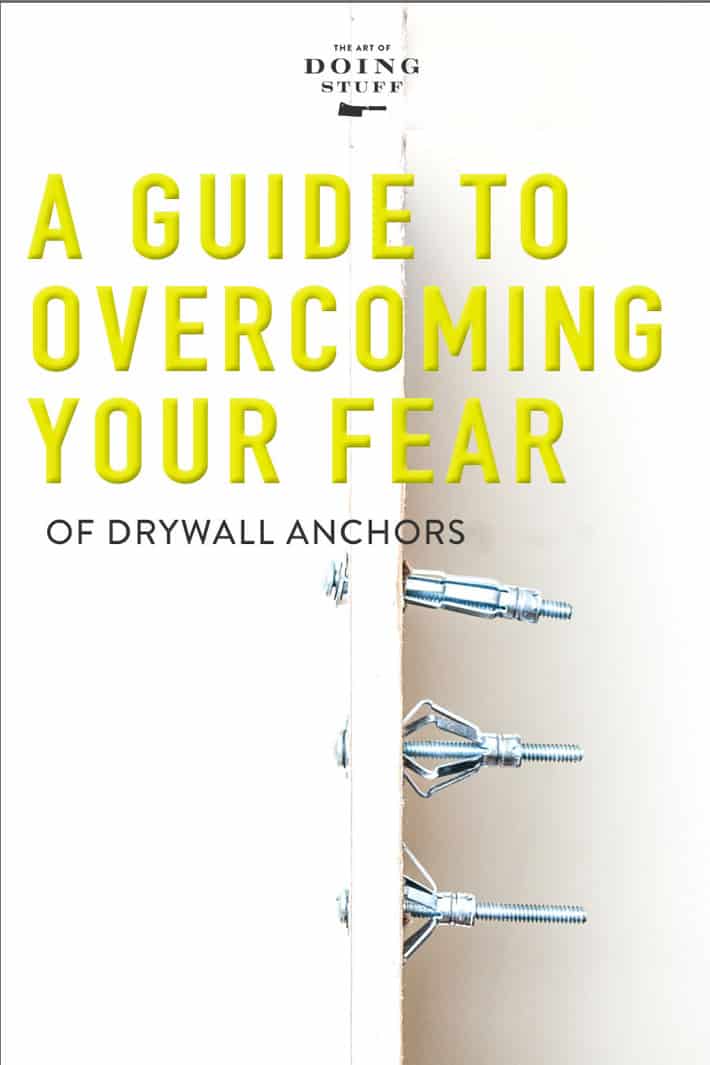


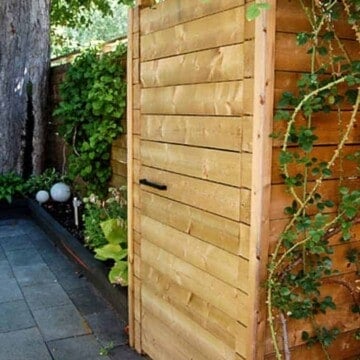
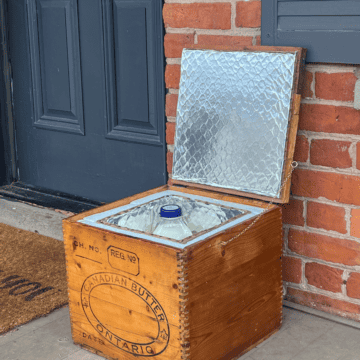
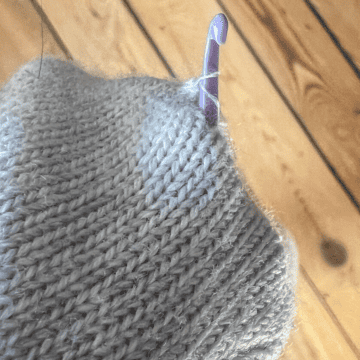

These el-cheapo plastic "butterfly" dry wall anchors are actually quite good for medium to light duty jobs.
http://www.toggler.com/products/plastic-toggle/installation.php
People complain that they come out, but that's because they don't know that they need to pop the "wings" open with a pin, as shown in the instructions at the link.
The Hilti HTB wall anchors are by far the best on the market and adjust to any wall thickness granted it isn't longer that the anchor itself. They are also easier to use, install, and hold up better over time.
Have a recommended brand? Since I couldn't remember the last brand I used (worked really well) I bought a pack of Hillman and they were the worst, either didn't expand at all (screw just freely spun round and round) or for the couple that did start to expand, they ended up shreading the wall, (expanded slightly and then were just stuck in that position).
Hi Jay. Is it possible you just didn't get the correct size for the thickness of your drywall? That could cause those problems too. ~ karen!
Dear Karen,
Your post on wall anchors was extremely well done and helpful - thank you! (Your post was much clearer and more thorough than several other posts I found on the internet on the subject, and thanks to you I was able to effectively install a heavy wood wall shelf/coat rack in my plaster wall correctly and sturdily!)
I was wondering if you have done, or might do, a post on installing a ceiling hook? I would like to install a ceiling hook which would be sturdy enough to hang a heavy 2-gallon plant pot. I have absolutely no experience with ceiling hooks and wouldn't know where to begin. I was hoping I might find a post about this on your blog, but my search for this topic came up negative. I'm guessing this issue may be quite similar to attaching something to a wall, but I'm not sure of any specific issues to be aware of for attaching something to a ceiling. And I don't know how one would use an anchor with a ceiling hook. Any advice?
Eileen
knew this in general but followed your advice-actually figured out how thick the drywall was-and got the anchors. I don't know why but I do the thing and the flanges don't open- I can pull the whole thing out and it's still skinny and closed. Hope I can figure it out. My walls are weird and ALL anchors seem to work their way out.Gaah. Love your blog. Any ideas on this?
I wish I had seen this three weeks ago....
I purchased the pointed plastic things, it dug up the drywall, building up under the top part as I tried to screw it into the wall, when it "stopped" still sticking out of the wall, I turned the screwdriver harder... said not to but, I wanted the anchor in the wall, not standing out from the wall... the plastic anchor broke, I was able to remove it, in pieces (that was fun)... leaving a big hole in the wall
I tried another on the hole that would hold the lower screw for the curtain rod bracket... it went less far in before it stopped... same procedure...
so, nearly 3/8" holes in the wall.... look too big for these anchors, I bet filling those holes with dry wall patch, won't support new anchors?
I'm afraid to try the curtain rod supposed to go up in the bedroom, have been staring at the the holes in the wall in the living room trying to figure out what to do next...
Will these anchors work for mounting pallet boards on the plaster walls. I want to cover the wall with pallet wood then hang cast iron cookware on the wood.
Hi Karen,
Storage closet in my basement has 4’ MDF shelves on drywall, each board supported by 2 metal brackets (underneath), one bracket toward each board end. Each bracket has 3 holes for screws. The owner before me installed them using plain old plastic anchors, so the brackets bent under the weight when I set average sz boxes on them (no heavy stuff like books, but some small appliances). The MDF board itself is pretty heavy, though. So
1. Can I get by just replacing plastic anchor with molly bolt in each hole? (x3 for each bracket—a lot of bolts!) Or
2. Do I need to use at least 1 toggle bolt/bracket (say for the bottom hole)? Or
3. Should I just get better brackets, and stick with all mollies? (I doubt I can straighten the bent bracket well enough, but I could just buy another.)
Advice, please! Thanks. ;)
(Btw, there two rows of 3 boards (each) next to each other—two ~12’ long shelves, one above the other.)
Hi Mary! Well if it were me, I'd probably start from scratch and do it all right. So replacing the brackets (if they're bent beyond repair) and all the plastic anchors with Molly bolts. If you're doing some of it, it doesn't take much more time or energy to do all of it. If your brackets are bent, your shelfs will never be nice and level. Since they're MDF which doesn't bent too much, you're probably O.K. with 2 brackets on each 4' shelf, but normally I'd also put a bracket in the centre of the shelf to stop any bowing. Possibly not the answer you're looking for, but there you have it. :) ~ karen!
We hung a barn door and it is now coming out of the drywall as the studs do not line up correctly. Can i use these eventhough there is already a hole there?
I'm mounting a television bracket to a wall in an older home. It doesn't have drywall or plaster. It's a fairly soft material that doesn't appear to be hollow. It's not particle board but leaves quite a bit of "dust" when drilled. It's approximately 3 7\8" thick. I tried the lag bolts but because the wall is not hollow (at least not where I need to mount) it wasn't able to open up. What type of anchor can I use to mount this bracket onto this particular wall? Thanks in advance.
Hi Ricky. I have no idea what material you could be working with. It's almost 4" thick? ~ karen!
Hi Karen,
I just discovered your blog, and I love it! Thanks for this clear explanation of how to use these bolts. Can I use it the same way for my walls, which are plaster? If not, what would you recommend for plaster? I need to hang a heavy wood wall shelf/coat rack - 17 pounds plus all the items it will hold, so we're talking 40-50 pounds total weight. (I noticed in the comments written soon after this post, you said you would make another post for plaster, but I couldn't find such a post by searching).
Your help for how to handle my plaster walls would be greatly appreciated!!
Hi Eileen! Molly bolts can be used in plaster but it's trickier you have to make sure you get one that's long enough (has a big enough space to accommodate the thickness of the plaster. The safest thing with plaster is to drill into studs but studs are a bit hard to find in plaster, plus ... we don't always want to hang things where the studs happen to be. :) So I'd go with Molly bolts as long as you make sure they're long enough. I've also had great success with those tiny plastic picture hangers with 3, short spikes on the back for hanging heavy pictures. ~ karen!
Hi Karen,
Thank you for a great post.
If only you also explained what the 3/16" size for in the first picture? It shows in the drywall thickness highlight which confuses me.
Is it the whole Molly Bolt size ? So that's a 5mm anchor that goes into a 10mm hole?
Wouldn't that leave a lot of wiggleroom ?
Hi Maury! The 3/16ths - 5/8ths is the range of drywall thicknesses the bolt will fit. It will self adjust as you tighten it. It isn't the thickness of the hole, it's the depth that it can tighten to. Does that make sense? ~ karen!
Now it does, yes.
Thanks to your explanation of course, Thanks a bunch.
3 years since posting this article and it is still as useful. You're getting points from God everyday :)
Just found a GREAT removal technique for these!!!
Use a drill bit just slightly larger than the hole in the anchor to remove the outer collar and then the hole is WAY smaller than pushing the entire anchor through the wall.
https://www.lowes.com/projects/repair-and-maintain/remove-unwanted-wall-anchors/project
For smaller jobs of 20 lbs or less per support (i.e. a shelf with two support brackets and 2 mount points per bracket = 80 lbs), plastic self-tapping screw-in drywall anchors or regular plastic anchors (drill and hammer type) are 1/100th the cost of these and easier to remove. Using anchors of this type for every job (as the headline suggests) is a bit paranoid and relatively expensive, but in some cases if it gives you peace of mind, go for it.
Literally did just this which landed me here because the shelf fell.
Karen, you're a master storyteller. This was a funny AND informative article. I learned that you can install the Molly and then remove the screw! I had lost all hope trying to hang a drop-leaf table. Thanks!
I've tried these before and instead of the flanges coming out when I screw in, the screw's coils (not the screw's head) strip, so I'm left with an anchor in a wall and no way to get the screw out because of the stripping. Is it possible mine are defective, or could I have gotten the wrong size? Thanks in advance for your reply - I know this blog post is 2 years old now :)
The no should NOT have been there!
OMG! Not only did I learn something valuable but you kept my attention & had me laughing until I cried!
Nicely done! I will no certainly come back for more!
Hello Karen,
I am getting a vertical long radiator fitted on the wall and following are the spec:
1. 15 KG radiator
2. Plus I would say another 30KG water in it.
So total say 50KGs for example.
Now the wall is a drywall/platerboard.
The guy who has come to fit it has FISCHER SELF-DRILL PLASTERBOARD FIXINGS METAL:
http://www.screwfix.com/p/fischer-self-drill-plasterboard-fixings-metal-35mm-100-pack/47347
And I am now confused what to choose between molly and these. Please advice.
Hey there. I'd go with what the installer has recommended. I'm sure he knows what he's doing. Although for something like that I would probably be installing it into studs. ~ karen!
Amazing work Karen! This all comes with experience and just like some of the readers have asked when to stop. It's very hard unless you are really passionate about that. ha ha!